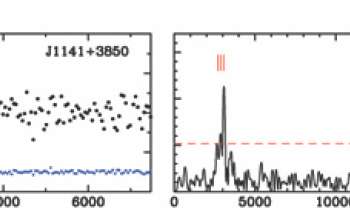sci16037 — Announcement
Helium Pulsations in Extremely Low-Mass White Dwarf Precursors
May 17, 2016
| Light curve (left) and Fourier amplitude spectrum (right) for the pulsating extremely low-mass white dwarf precursor J1141+3850. The red tick marks denote the significantly detected frequencies. |
Stars can reveal their internal structures through pulsations that are detectable from the outside. In the case of several extremely low-mass white dwarf precursors, Alexandros Gianninas (University of Oklahoma) and collaborators show that helium in the atmosphere is required for such a star to be unstable to pulsations. The researchers used the Gemini Multi-Object Spectrograph (GMOS) on the Gemini North telescope along with the 1.2-meter telescope at the Fred Lawrence Whipple Observatory in Arizona to measure the lightcurves earlier this year. The work is featured at the Gemini website, and the full results are published in The Astrophysical Journal Letters.
About the Announcement
| Id: |
ID
sci16037
|
